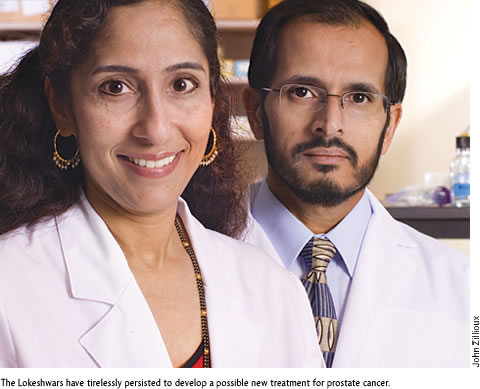|

It’s probably safe to say that no one would have blamed Bal Lokeshwar, Ph.D., and Vinata Lokeshwar, Ph.D., if they had given up on trying to get a grant to study a potential breakthrough treatment for prostate cancer. But at each roadblock, these Miller School researchers just dug deeper for answers. It turned out to be a labor of love that would take them, via the Internet and phone lines, around the world.
The adventure for these associate professors and researchers in the Department of Urology started many years ago in the jungles of Ecuador. That’s where a plant known as dulcamara is grown, and a medical oncologist, Edwin Cevallos, M.D., has developed it into a product called BIRM (Biological Immune Response Modifier). It’s easily purchased in Ecuador. “They gave it as an immune booster so a lot of people could take it whether they had a problem or not,” Bal Lokeshwar explained. One of the people who took it was Christian Degetau, a longtime patient of Mark Soloway, M.D., professor and chairman of the Department of Urology at the Miller School and a world renowned leader in treating prostate and bladder cancers.
Soloway had begun treating Degetau more than a dozen years ago; he operated on his locally advanced prostate cancer. One day in 2001, Degetau told Soloway he was taking BIRM. “He thought it was helping him,” says Soloway, who is the leader of the Prostate, Bladder and Kidney Cancer Site Disease Group at UM/Sylvester. “It’s hard to know objectively whether it helped him or not.”
Soloway knew it needed testing. That is how a plant from the Ecuadoran jungle, made into syrup, landed in the laboratory of Bal Lokeshwar. “He told us, ‘You should try this in your lab,’” says Lokeshwar, who then began testing it on rats with prostate cancer. BIRM worked.
Lokeshwar shared the results with his wife, Vinata, whose research centers on bladder cancer. They discovered that BIRM worked by inducing programmed cell death, or apoptosis, which involves a series of biochemical events leading a cell to destroy itself. BIRM “stops the growth by inhibiting cell cycle at a certain stage, and then the cells undergo apoptosis.”
In 2003 they had learned enough in the laboratory to publish their work in the journal Cancer Chemotherapy and Pharmacology. Over the next two years they tested BIRM on mice that readily develop tumors when injected with human cancer cells. The results were encouraging. The tumors stopped growing and didn’t spread in the body.
Four years after BIRM first landed on Bal’s desk, the Lokeshwars applied for a grant from the National Center for Complementary and Alternative Medicine (NCCAM) of the National Institutes of Health. Their research paid off. One year later, the Scientific Review Group approved their application but wanted more information about BIRM and how it is made before they would release funding.
They didn’t know that the next year would become what Vinata calls “more interesting than the DaVinci Code.”
“We thought they would want what we have, where it was manufactured, just what we know off the bottle,” Vinata explains. “So we thought: great, that’s done.”
They were far from done. The NCCAM came back with 20 questions, asking for details about the plant, temperature, and even soil conditions. The list of queries about a plant from the Amazon seemed endless and impossible to answer for these researchers who were thousands of miles away, inside a medical school lab.
That’s when they started working the phones and the Internet. They needed to provide the NCCAM with a specimen of the plant. The problem was Cevallos wasn’t so willing to share information on the plant, especially since he was trying to get a patent on BIRM.
But through persuasion and the help of her lab research associate, Luis Lopez, Vinata was able to convince Cevallos’s daughter that this research would help many people, a goal that both the Cevalloses shared. They finally provided a sample of the plant, and Hugo Navarrete, Ph.D., at the Catholic University of Quito helped to identify it as dulcamara.
That information went to the NCCAM, which now wanted a chemical analysis of dulcamara. “We searched the entire Web. PubMed, AgriNet, National Library of Medicine, Google-search, Yahoo!, everything,” says Vinata. But they couldn’t find information on the chemical in dulcamara.
Lopez, the research associate, came to the rescue again. He found a scientist in Africa who had worked on plants from the same species. They also tracked down a chemist in Brazil, one in North Carolina, and another in Germany who would do the analysis.
Donatus Okwu, Ph.D., a chemist in Nigeria, agreed to prepare a protocol for isolating the chemical. The scientist in Germany would perform the NMR spectroscopy to identify the chemical structure of the compounds, and in Brazil, chemist Sonia Costa, Ph.D., agreed to interpret the results.
Finally, with a team of experts signed on and NCCAM satisfied with the background information and assured of the quality control for BIRM, the NIH gave the $1.2 million grant a final stamp of approval. Over the next four years, with the help of his research associate, Dominic Lyn, and others in his group, Bal Lokeshwar hopes to determine whether BIRM will be a viable long-term treatment to slow the progression of prostate cancer. Soloway points out that “the idea is to try and make cancer into a chronic disease so the person lives comfortably and takes medication like they do for diabetes and other things.”
Amid this endless search for information, Bal admits they thought about giving up. So why persevere? “Because of curiosity and a zeal to discover. That’s what scientists do.” |


